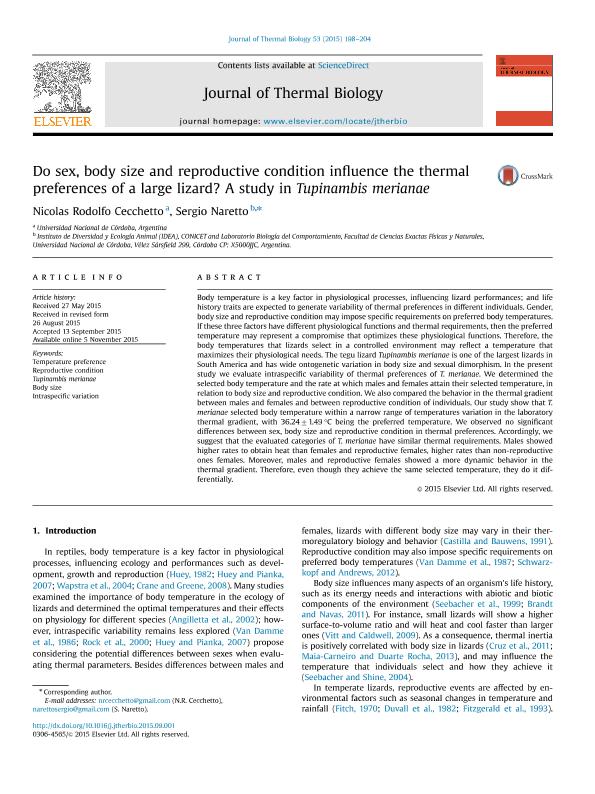Mostrar el registro sencillo del ítem
dc.contributor.author
Cecchetto, Nicolas Rodolfo

dc.contributor.author
Naretto, Sergio

dc.date.available
2023-09-22T14:35:30Z
dc.date.issued
2015-09
dc.identifier.citation
Cecchetto, Nicolas Rodolfo; Naretto, Sergio; Do sex, body size and reproductive condition influence the thermal preferences of a large lizard?: A study in Tupinambis merianae; Pergamon-Elsevier Science Ltd; Journal of Thermal Biology; 53; 9-2015; 198-204
dc.identifier.issn
0306-4565
dc.identifier.uri
http://hdl.handle.net/11336/212683
dc.description.abstract
Body temperature is a key factor in physiological processes, influencing lizard performances; and life history traits are expected to generate variability of thermal preferences in different individuals. Gender, body size and reproductive condition may impose specific requirements on preferred body temperatures. If these three factors have different physiological functions and thermal requirements, then the preferred temperature may represent a compromise that optimizes these physiological functions. Therefore, the body temperatures that lizards select in a controlled environment may reflect a temperature that maximizes their physiological needs. The tegu lizard Tupinambis merianae is one of the largest lizards in South America and has wide ontogenetic variation in body size and sexual dimorphism. In the present study we evaluate intraspecific variability of thermal preferences of T. merianae. We determined the selected body temperature and the rate at which males and females attain their selected temperature, in relation to body size and reproductive condition. We also compared the behavior in the thermal gradient between males and females and between reproductive condition of individuals. Our study show that T. merianae selected body temperature within a narrow range of temperatures variation in the laboratory thermal gradient, with 36.24±1.49. °C being the preferred temperature. We observed no significant differences between sex, body size and reproductive condition in thermal preferences. Accordingly, we suggest that the evaluated categories of T. merianae have similar thermal requirements. Males showed higher rates to obtain heat than females and reproductive females, higher rates than non-reproductive ones females. Moreover, males and reproductive females showed a more dynamic behavior in the thermal gradient. Therefore, even though they achieve the same selected temperature, they do it differentially.
dc.format
application/pdf
dc.language.iso
eng
dc.publisher
Pergamon-Elsevier Science Ltd

dc.rights
info:eu-repo/semantics/openAccess
dc.rights.uri
https://creativecommons.org/licenses/by-nc-nd/2.5/ar/
dc.subject
BODY SIZE
dc.subject
INTRASPECIFIC VARIATION
dc.subject
REPRODUCTIVE CONDITION
dc.subject
TEMPERATURE PREFERENCE
dc.subject
TUPINAMBIS MERIANAE
dc.subject.classification
Biología

dc.subject.classification
Ciencias Biológicas

dc.subject.classification
CIENCIAS NATURALES Y EXACTAS

dc.title
Do sex, body size and reproductive condition influence the thermal preferences of a large lizard?: A study in Tupinambis merianae
dc.type
info:eu-repo/semantics/article
dc.type
info:ar-repo/semantics/artículo
dc.type
info:eu-repo/semantics/publishedVersion
dc.date.updated
2023-09-22T13:14:19Z
dc.journal.volume
53
dc.journal.pagination
198-204
dc.journal.pais
Países Bajos

dc.journal.ciudad
Amsterdam
dc.description.fil
Fil: Cecchetto, Nicolas Rodolfo. Universidad Nacional de Córdoba; Argentina. Consejo Nacional de Investigaciones Científicas y Técnicas. Centro Científico Tecnológico Conicet - Córdoba; Argentina
dc.description.fil
Fil: Naretto, Sergio. Consejo Nacional de Investigaciones Científicas y Técnicas. Centro Científico Tecnológico Conicet - Córdoba. Instituto de Diversidad y Ecología Animal. Universidad Nacional de Córdoba. Facultad de Ciencias Exactas Físicas y Naturales. Instituto de Diversidad y Ecología Animal; Argentina
dc.journal.title
Journal of Thermal Biology

dc.relation.alternativeid
info:eu-repo/semantics/altIdentifier/doi/http://dx.doi.org/10.1016/j.jtherbio.2015.09.001
dc.relation.alternativeid
info:eu-repo/semantics/altIdentifier/url/https://www.sciencedirect.com/science/article/pii/S0306456515300164
Archivos asociados
